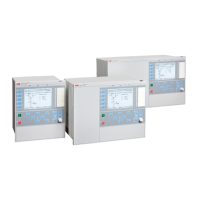7. Apply a fault condition in the forward directed zone used for scheme communication
tripping.
8. Check that the no trip from scheme communication occurs.
9. Check that the trip time from the forward directed zone used for scheme
communication tripping complies with the zone timer and that correct trip outputs,
external signals, and indications are obtained for the actual type of fault generated.
11.11.2.4 Completing the test
Continue to test another function or end the test by changing the TESTMODE setting to
Disabled. Restore connections and settings to their original values, if they were changed
for testing purposes.
11.11.3 Current reversal and Weak-end infeed logic for distance
protection 3-phase ZCRWPSCH (85)
Prepare the IED for verification of settings outlined in Section "Preparing the IED to
verify settings".
Values of the logical signals for ZCRWPSCH are available on the local HMI under Main
menu/Tests/Function status / Scheme communication / ZCRWPSCH(85) /ZCRWPSCH:
1.
The Signal Monitoring in PCM600 shows signals that are available on the Local HMI.
The current reversal logic and the weak-end infeed functions are tested during the
secondary-injection test of the impedance or overcurrent protection zones together with
the scheme communication logic for the distance protection function ZCPSCH (85).
11.11.3.1 Current reversal logic
It is possible to check the delay of the CS send signal with tDelayRev by changing from
a reverse to a forward fault.
By continuously activating the CR input and changing from a reverse to a forward fault,
the delay tDelayRev can be checked.
Checking of current reversal
The reverse zone timer must not operate before the forward zone fault is
applied. The user might need to block the reverse zone timer setting during
testing of current reversal.
1MRK 504 165-UUS - Section 11
Testing functionality by secondary injection
Transformer protection RET670 2.2 ANSI 263
Commissioning manual

